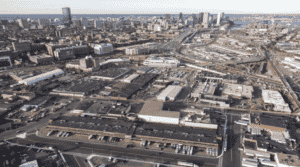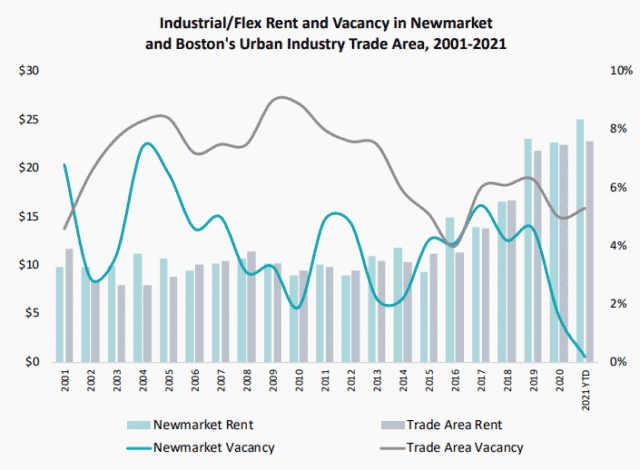
Long-time tenants say spiraling rents threaten one of the last industrial pockets in Boston’s core. Now the city is considering rezoning for higher-priced uses including life science. Photo courtesy of the BPDA
Boston’s Newmarket neighborhood usually pops up in headlines as the epicenter of the region’s opioid crisis and a steady source of street crime.
In another era, it could be a nightmare scenario for real estate investors. But in 21st century Boston, real estate values defy gravity and displacement pressures spread throughout the city – even in gritty Newmarket. Long-time industrial tenants wonder whether rent hikes will force them to leave and whether the century-old factory buildings and low-slung warehouses will be demolished to make way for biomanufacturing or life science labs.
“When the city was entertaining hosting the [2024] Olympics, they realized there’s a lot of space here and there was almost a land grab that went on,” said Sheldon Lloyd, CEO of City Fresh Foods. “It’s really accelerated after that.”
The rent rose 150 percent when City Fresh Foods renewed the lease for its 19,000-square-foot commercial kitchen in 2019. At its Shirley Street location, 150 employees cook and assemble meal kits for delivery to schools, daycare centers and Meals on Wheels programs.
The Boston Planning & Development Agency recently launched a planning study that could result in rezoning of the industrial district. The area was last rezoned in 2014 to preserve the manufacturing and distribution tenants that are still being forced out by housing developments and commercial uses in many other neighborhoods.
Will Life Science Development Come Next?
Located at the crossroads of Roxbury, Dorchester and South End, Newmarket has long been a haven for companies that support the day-to-day needs of the city. Building equipment suppliers, commercial kitchens and construction companies share the neighborhood with architects, microdistilleries and artists who were displaced from neighborhoods such as Fort Point in recent decades. Nearby Widett Circle faces similar pressures, as dozens of food wholesalers begin to depart following a development team’s acquisition of the 19-acre parcel in 2020.
At a recent community meeting hosted by the BPDA, potential expansion by e-commerce companies and life science developers was the elephant in the virtual room. The study will include an analysis of whether to permit life science uses and if so, in which sections of the district, BPDA urban designer Alexa Pinard said.
Even under the current zoning, rents for industrial spaces now approach $25 per square foot, said Sue Sullivan, executive director of the Newmarket Business Association.
“Many of these traditional industrial companies cannot afford the space,” Sullivan said.
Industrial vacancies in Newmarket have plummeted to below 1 percent, according to data provided to the BPDA by real estate researchers CoStar Group.
Creative economy tenants have been drawn to the neighborhood as well, lured by comparatively affordable rents and the eclectic mix of tenants sharing buildings. RODE Architects occupies a former turning mill on Albany Street that also includes artisans, designers and professional offices, expanding from its home office roots to a workspace for 30 employees.
“Newmarket seems to be one of the last places you can build things and be supported by most of the landowners,” Principal Kevin Deabler said. “Our landlord supports these creative businesses in keeping the rents very reasonable, and that sort of thing is rare.”

Image courtesy of the BPDA and CoStar Group
Calls for Help from Mayor
In spite of the rising real estate market, local business leaders say conditions in the northern corner of the district require immediate intervention by city officials. The public health crisis has been attributed to the concentration of substance abuse treatment facilities near the corner of Massachusetts Avenue and Melnea Cass Boulevard, coupled with the Southampton Street Shelter’s arrival in 2015.
The Newmarket Business Association is finalizing plans to create a business improvement district funded by property tax surcharges to pay for services such as sidewalk cleanups and shuttle buses from businesses to public transit.
Concerns about street crime have made it harder for some association members to hire employees, Sullivan said at the recent BPDA forum.
“It’s not perceived safety, it’s actual safety,” Sullivan said. “We’ve had 15 stabbings down here in the last two weeks.”
Two Boston men were charged in April with the Jan. 4 stabbing death of a 23-year-old Medford resident on Southampton Street.
The neighborhood turmoil has become a flashpoint in the mayoral race. In January, councilor and mayoral candidate Andrea Campbell released a plan to appoint a cabinet-level position focusing on the crisis, decentralize the cluster of service agencies, create a first-responder unit for the district, reactivate the Long Island shelter using a ferry service, add mobile treatment services and convert vacant and underutilized properties throughout the city into treatment facilities.

Steve Adams
Acting Mayor Kim Janey said last week the city might be able to reopen the Long Island Recovery Center by running ferries to the Boston Harbor Island. The 2014 closure of the shelter has been cited as a contributing factor to the city’s homeless crisis, after the bridge linking the island to the mainland in Quincy was condemned.
Responding to an inquiry from Banker & Tradesman, city councilor and mayoral candidate Annissa Essaibi George said she would reopen the Long Island center as soon as possible. The other mayoral candidates did not respond.
“The Newmarket area needs a coordinated response to not only address the public health crisis at Mass and Cass, but revitalize the neighborhood and businesses there by encouraging mixed-use development, better transit, and job growth,” Essaibi George said in a statement.




 |
| 